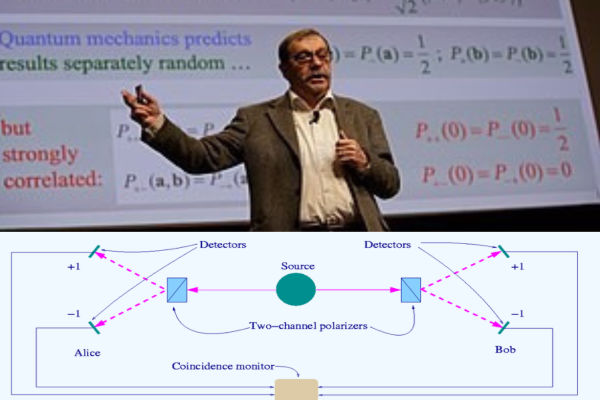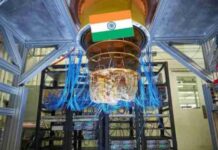The topic of quantum entanglement is at the heart of the disparity between classical and quantum physics, entanglement is a primary feature of quantum mechanics not present in classical mechanics. An entangled system is defined to be one whose quantum state cannot be as a product of states of its local constituents that is to say, they are not individual particles but are an inseparable whole. In entanglement, one constituent cannot be fully described without considering other(s). In simple words, if someone tries to explain entanglement it can be done by supposing a parallel universe where your copy is there and as the theory states that supposed to do a work there is a probability of that either it will be done or it will be not, and the person present in this universe will not do the work but the person of the parallel universe which is a copy of yours will do it. This is an example of entanglement not fully. This is a fiction story but in real, it can be thought as of the spin of photon that if the spin of photon here is up then the entangled photon will have a spin down. This can be made only true if the two particles are made in contact with each other so they can become entangled but in the case of parallel universe we two had never interacted or if then it is unpredictable that it happened or not. Photons are the real example of entanglement as they show completely phenomenon of entanglement.
Connecting entanglement with quantum mechanics is making entanglement true. Classical or classical particles doesn’t show any entanglement processes as they are macroscopic objects in classical mechanics and till now it has been only possible entangling two or more microscopic or quanta size particles, or we can say only quanta size particles had shown the entanglement. Entanglement is a property that if two particles got entangled then whatever their distance be, they will show the property of the same as their entangled one means the distance between them doesn’t matter. Now there is a question on relativity that it is impossible to communicate or making changes faster than speed of light and if this is true it’s violating the laws of physics. It’s not true because quantum mechanics is a place or quanta size particles where time runs on some of different measure, it’s not as same as real world it becomes slower and slower so entanglement is not violating the laws of physics, it is just connecting us to a new world or I say to the quanta world. Entanglement is the most fascinating topic in today’s world because it seems not to be true but it is true and our scientists and many researchers are trying to prove this true and for this, three scientists got Nobel prize in 2022 to understand quantum entanglement and advancing the field of quantum information.
What is Quantum Entanglement?’
Quantum Entanglement is a physical phenomenon that occurs when, in two or more particles, the quantum state of each particle cannot be described independently of the state of the others, including even when the particles are separated by a large distance. Quantum Entanglement really is “spooky action at a distance”. It is one of the phenomena seen when things get inside the quantum realm. When two or more particles link up in a certain way, no matter how far apart they are in space, their states remain linked. That means they share a common quantum state. And any action to one of these particles will invariably impact the others in the entangled system. Entanglement is usually created by direct interactions between subatomic particles. These interactions can take numerous forms. One of the most commonly used methods is spontaneous parametric down conversion to generate a pair of photons entangled in polarization. Other methods include the use of a Fiber coupler to confine and mix photons, photons emitted from decay cascade of the bi-excitation in a quantum dot. In the earliest tests of Bell’s theorem, the entangled particles were generated using atomic cascades.
Superposition plays an important role to show entanglement between two or more particles. Superposition means the combination of two distinct physical phenomena of the same type (such as spin or wavelength) so that they coexist as part of the same event. In the quantum world, particles can exist in a state of superposition, which means that they can be in the multiple states at the same time. Quantum superposition is the idea that particles can exist in multiples states at once. When a measurement is performed, it is as if the particle selects one of the states in the superposition. For example, many particles have an attribute called spin that is measured either as “up” or “down” for a given orientation of the analyser. But until you measure the spin of a particle, it simultaneously exists in a superposition of spin up and down.
EPR Paradox and Bell’s Theorem
Einstein, Podolsky and Rosen paradox is a thought experiment proposed by Albert Einstein, Boris Podolsky and Nathan Rosen, they argued that the description of physical reality can be considered as incomplete. In 1935 paper named “can quantum mechanical description of physical reality be considered complete?” in which they argued about the existence of “elements of reality” that were part of quantum theory. This thought experiment involves that a pair of particles prepared which is now known as entangled state. They said that if they are entangled then measuring one particle can give us the information of the other particle without getting connected to other or knowing any position and momentum of the other particle, we can predict its state and whatever quantum phenomenon. Bell’s theorem asserts that if certain predictions of quantum theory are correct that our world is non local. “Non-local” here means that there exists interaction between events that are too far apart in space and too close together in time for the events to be connected even by signals moving at the speed of light. This theorem was proved by John Stewart Bell in 1964. The proof of bell’s theorem is obtained by combining the EPR argument and Bell’s inequality theorem.
Quantum Entanglement in Action
In 1982, famous scientist Alain Aspect demonstrated the first quantum mechanics experiment to show the violation of Bell’s inequalities with photons using distant detectors, its result allowed for further violation of quantum entanglement and locality principles. It gives an experimental answer to EPR’s paradox. For his work on this topic, Aspect was awarded part of the 2022 Nobel Prize in Physics. This experiment was able to modify the angle of polarizers while the photons were in flight, faster than what light would take to reach the other polarizer, removing the possibility of communication between detectors.

Aspect Experiment. The source S produces pairs of “photons”, sent in opposite directions. Each photon encounters a two-channel polariser whose orientation can be set by the experimenter. Emerging signals from each channel are detected and coincidences of four types (+-, ++, -+, –) counted by the coincidence monitor. A key element of Aspect’s experiment is that the angle of the polarisers can be quickly modified while the photons are travelling.
A famous experiment recently has been performed in 2016 to define quantum entanglement experimentally. This experiment told us about the quantum nonlocality (it is widely believed to confirm the existence of quantum non locality), post selection loophole (it remains open), Post selection (post selection loophole requires that some fraction of the full data of the experiment is absent from or not considered in the data analysis, producing only an artifactually violation of the applicable Bell-like inequality), Local Realism (The Hensen et al. experiment does not succeed in rejecting local realism), CHSH Inequality (The experiment’s results show a significant violation of the CHSH inequality), Classical limit (A local numerical simulation model saturating the CHSH inequality at the classical limit of 2, together with variable post selection of {00} mismatch events).
Applications and Implications
Quantum Cryptography: Entanglement can be used to create a secure communication channel between two parties. This is because entangled systems are correlated with each other, and no third party can share this correlation.
Superdense Coding: Entanglement allows for the transportation of two classical bits of information using one entangled qubit. This means that a user can send two bits of information at once, increasing data transmission rates.
Quantum Teleportation: Entanglement allows for the exchange of quantum information between two parties. This can be used to perform quantum computations in parallel, reducing power consumption.
Improved Microscopy: Entanglement can be used to increase the sensitivity of instruments, such as microscopes. This can lead to advances in fields like nanotechnology.
Quantum Computing: Entanglement is a key feature of quantum mechanics that can be used to perform quantum computations. This can solve problems that are too complex for classical computers.
Biological Systems: Entanglement may play a role in biological systems, such as the way proteins are structured. This could lead to advances in medicine and our understanding of biological processes.
Quantum Key Distribution: Entanglement can be used to distribute secure keys for encrypting and decrypting information. This is already being used in some applications.
Secure Communication: Entanglement can be used to create secure communication channels for military, financial, and other applications.
Quantum Simulation: Entanglement can be used to simulate complex quantum systems, which can lead to advances in fields like chemistry and materials science.
Quantum Metrology: Entanglement can be used to increase the precision of measurements, which can lead to advances in fields like navigation and spectroscopy.
Entanglement implementation involves creating and manipulating entangled states in various physical systems. Here are some ways entanglement is implemented:
1. Photons: Entangled photons are created through nonlinear optical processes like spontaneous parametric down-conversion (SPDC) or four-wave mixing (FWM).
2. Atomic Systems: Entangled atoms are created through interactions like cold collisions or Rydberg blockade.
3. Superconducting Qubits: Entangled qubits are created through controlled gate operations and coupling between qubits.
4. Trapped Ions: Entangled ions are created through laser-induced interactions and Coulomb repulsion.
5. Optical Lattices: Entangled atoms are created through controlled tunneling and interactions in optical lattices.
6. Quantum Dots: Entangled quantum dots are created through controlled coupling and exciton transfer.
7. Topological Systems: Entangled quasiparticles (anyons) are created through braiding operations in topological systems.
8. Nitrogen-Vacancy (NV) Centres: Entangled NV centres are created through controlled microwave and optical interactions.
9. Quantum Gates: Entangled qubits are created through controlled quantum gate operations like CNOT, Hadamard, and Pauli-X.
10. Quantum Error Correction: Entangled qubits are used to encode and decode quantum information, protecting it from errors.
These implementations are crucial for various applications, including quantum computing, quantum communication, and quantum metrology. Researchers continue to explore new ways to create and manipulate entangled states, pushing the boundaries of quantum science and technology.













